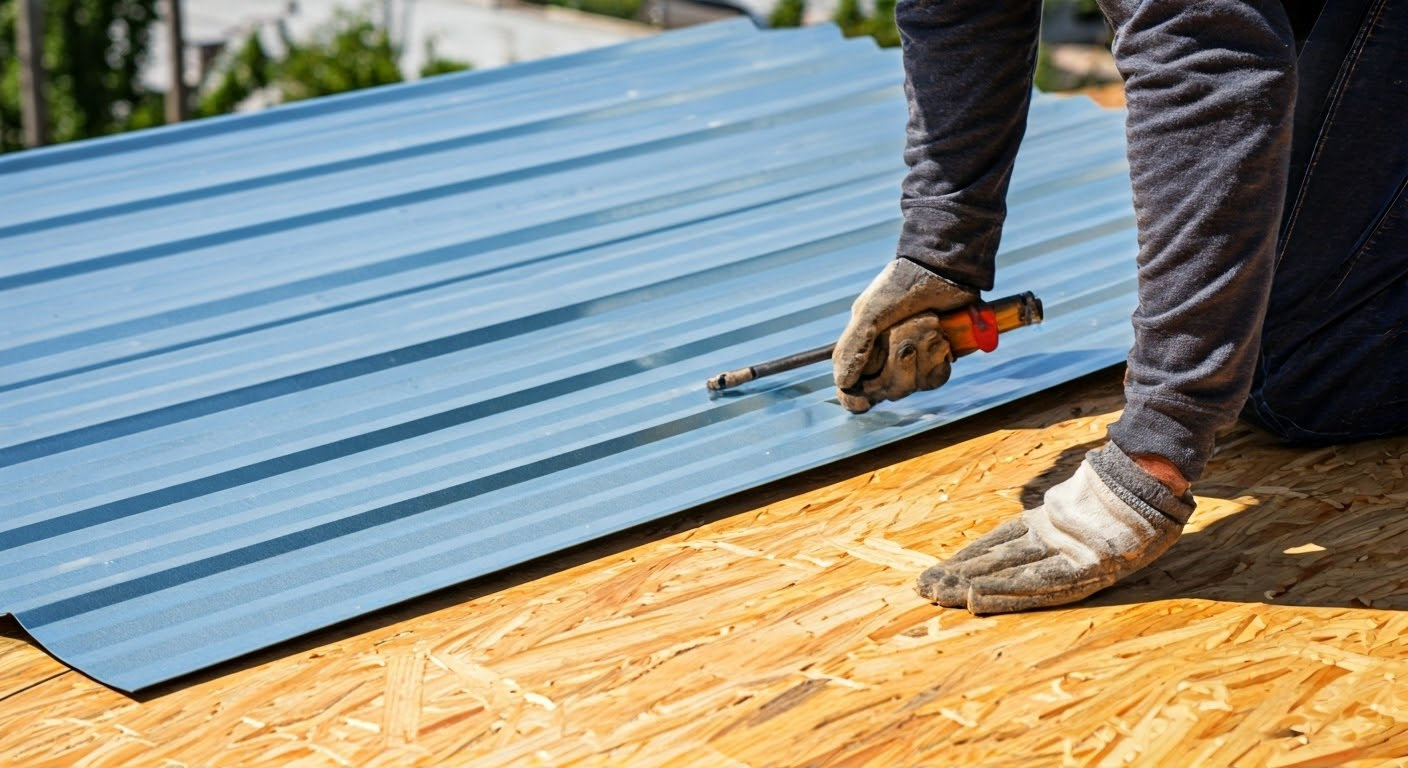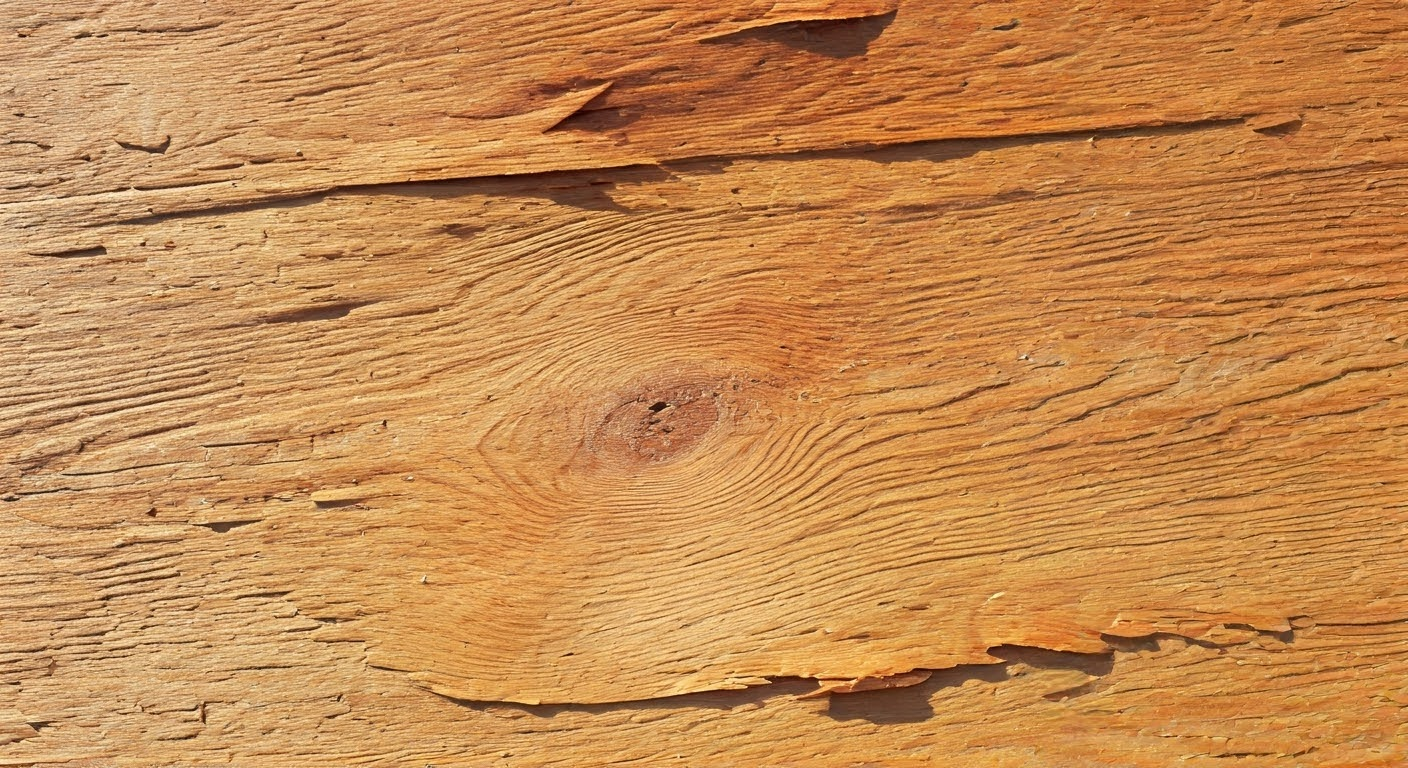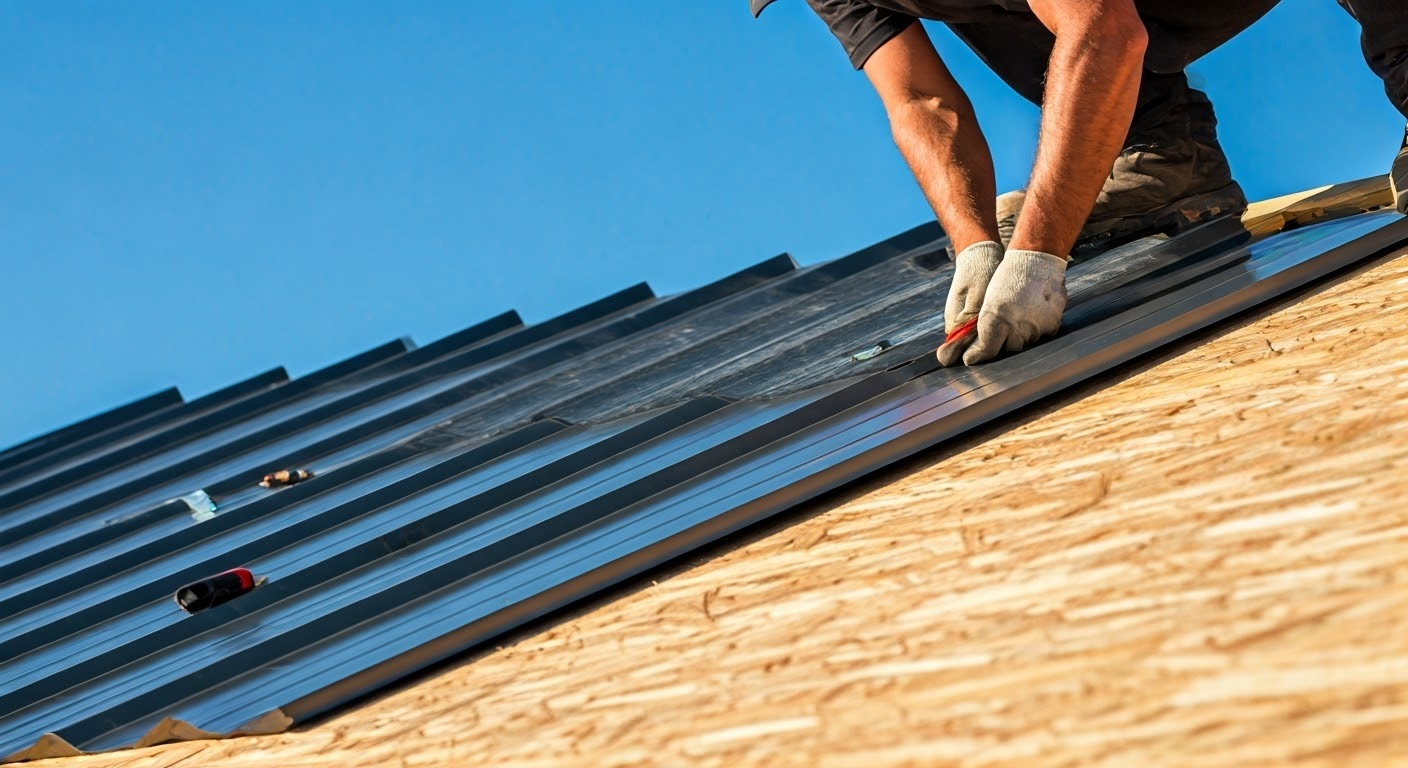
Key Highlights
- Before installing a metal roof, it is vital to inspect the plywood for damage and ensure it meets industry standards for thickness and durability.
- Common plywood issues like rotting, moisture absorption, and leaks must be addressed to avoid long-term structural problems.
- Preparing the plywood involves cleaning, using the correct underlayment, and securing metal screws for durability.
- Proper alignment, sealing techniques, and the use of slip sheets ensure maximum protection from weather elements.
- Selecting high-quality underlayment and metal roofing materials significantly impacts the roof’s longevity and warranty benefits.
Introduction
Installing metal roofing over part of your home plywood can be a durable and efficient roofing solution for your home. As a versatile roofing material, metal roofs offer excellent durability, energy efficiency, and weather resistance. However, the success of this installation largely depends on your plywood’s condition and proper preparation. Plywood serves as the foundation of the roof, supporting the weight and structural needs of the metal panels. By following the right steps, you can ensure a secure and reliable installation that stands the test of time.
Importance of Plywood Condition for Metal Roofing

The condition of your plywood plays a pivotal role in the successful installation of metal roofing. As the foundational roofing material, plywood provides insulation and support for the roof’s fasteners and serves as a critical barrier between the metal panels and the substructure. For optimal results, the plywood must be sturdy, free of rot, and compliant with industry standards, such as those set by the American Plywood Association (APA).
Inspecting and maintaining plywood is essential, as issues like moisture damage or improper thickness can compromise the entire roofing system. Use APA stamp plywood with a minimum thickness of 15/32 inches for structural integrity. If the substrate is not in good condition, it will fail to withstand external stresses, such as wind, snow, or heavy rain, leading to potential leaks or improperly distributed weight. Replacing inadequate plywood before starting the installation ensures long-term durability and safety.
Identifying Common Issues with Plywood Substrates
Plywood, as a substrate, is prone to several common issues that can jeopardize the roof’s effectiveness. One major concern is moisture absorption resulting from prolonged exposure to rain or condensation. When moisture seeps into plywood, it can lead to swelling, weakening the material over time. This compromises its ability to support the roofing system.
Another prevalent issue is the presence of soft or rotting sections in the plywood. These areas often emerge due to age or preexisting leaks, rendering the plywood structurally unfit. Ignoring such problems can increase the risk of mold formation, further deteriorating the substrate.
Raised or protruding nails are another problem that homeowners may overlook. These can disrupt the integrity of the metal roofing and lead to improper alignment during installation. Therefore, thorough inspection and addressing any substrate issues are crucial before proceeding with a new metal roof installation.
Preparing Plywood for Metal Roof Installation
Proper preparation of plywood is essential for a successful metal roof installation. Start by thoroughly cleaning the surface, removing dirt, dust, and any nails or debris that can interfere with the underlayment or metal sheets. This clean base ensures better adhesion and reduces the likelihood of future issues.
Before you begin, address important steps:
- Replace any damaged or rotting plywood panels to create a sturdy foundation.
- Use APA-approved plywood with a minimum thickness of 15/32 inches to comply with structural standards.
- Hammer down or remove all raised nails to avoid panel misalignment.
Additionally, install an underlayment that acts as a layer of protection between the plywood and the roof system. Enhance durability by securing the underlayment with metal screws, ensuring stability during extreme weather conditions. A well-prepared foundation is critical for ensuring the longevity and effectiveness of your metal roof.
Essential Steps Before Installing Metal Roofing
Before you begin installing metal roofing, conduct a comprehensive inspection of the original roofing plywood. Look for signs of damage such as rotting, raised nails, or warping. Any compromised pieces of sheathing must be replaced to strengthen the structure.
Additionally, plan for the use of high-quality roofing material, including underlayment and slip sheets. Both are crucial for protecting the plywood from moisture and external wear, as well as from any protrusions that may affect the roof structure. Detail-oriented preparation ensures that the roofing system holds up against environmental pressures while providing long-lasting performance.
Choosing the Right Type of Metal Roofing Materials
Selecting appropriate metal roofing materials can significantly affect your roof’s durability and warranty. First, consider the type of metal—popular options include aluminum, steel, and copper. Each has unique qualities, such as rust resistance or lightweight features, making them suitable for various climates and applications.
Additionally, it’s important to evaluate the roofing material’s warranty. Many manufacturers offer warranties that cover corrosion, wear, and defects, ensuring peace of mind for homeowners. Check the warranty length and conditions thoroughly before making a purchase.
Aesthetics may also play a role in your choice. Metal roofs come in an array of colors and finishes, allowing you to match your roof to the architectural style of your home. By considering factors like cost, functionality, and visual appeal, you can choose roofing materials tailored to your specific needs.
Importance of Using an Underlayment
An underlayment, commonly known as roofer’s felt, is a critical component in metal roofing, acting as a layer of protection between the metal sheets and the plywood substrate. This material provides secondary weather resistance, preventing water infiltration that could damage the plywood.
There are several types of underlayment to consider, such as synthetic, asphalt, and polymer-based solutions. Synthetic underlayment is often preferred for its durability and moisture resistance. Asphalt-based options offer affordability, while polymer formulations combine flexibility with strength.
To install an underlayment, measure and roll it out evenly across the plywood, securing it with ½-inch nails. This step minimizes the risk of tears or leaks as the metal expands and contracts with temperature changes. Additionally, a slip sheet can be placed on top of the underlayment for enhanced durability. Proper use of both materials ensures your roofing system remains watertight and long-lasting.
Detailed Installation Process of Metal Roofing Over Plywood

To install metal roofing over plywood shingles, begin by ensuring the plywood surface is clean and level. Next, apply an underlayment across the entire roof area, securing it with roofing nails. This provides a protective barrier against moisture while stabilizing the foundation for the metal panels.
After preparing the plywood substrate, install the metal roof panels sequentially. Start at the bottom corner, aligning the first panel flush with the edge of the roof, leaving a 1-inch overlap. Use galvanized screws placed every 12-16 inches to secure the panels firmly.
Continue working upward and follow this pattern for all rows of panels. Align carefully to avoid gaps or wrinkling that may lead to water leaks. By carefully following this process, you can achieve a sturdy, well-installed metal roof with lasting durability.
Step-by-Step Guide to Securely Fixing Metal Panels
Installing metal panels securely begins with proper anchoring. Start at the roof’s bottom-left corner, laying the first panel beyond the old roof eave by about 1 inch. Secure the panel using fasteners spaced 12-16 inches apart, ensuring a snug fit.
Once the initial panel is set, overlap the next panel over it by approximately 12 inches. Align the edges precisely, and follow the same fastening procedure to secure it. Continue this alignment and fastening across the row of panels until the entire roof area is covered.
To complete the process, use metal snips to trim excess material from the final panels, ensuring they fit perfectly. Additionally, install rubber pipe boot kits around vent pipes to prevent leaks. By addressing every step methodically, the roof remains aligned, secure, and functional against the elements.
Ensuring Proper Alignment and Sealing Techniques
Proper alignment and sealing techniques are key for a watertight roof. To achieve this, begin by measuring each panel’s placement to ensure all edges align evenly. Misalignment can lead to water pooling or drainage issues along the edge of the roof.
Next, focus on sealing the roof, which involves caulking seams and overlaps. Use a high-quality roofing sealant designed specifically for metal roofs. Apply the sealant in smooth, consistent layers to prevent air or moisture infiltration.
| Area | Technique | Purpose |
|---|---|---|
| Seams | Caulking with roofing sealant | Prevents leaks and drafts |
| Overlaps | Bonding panels with sealant | Enhances structural strength |
| Roof edges | Sealing between materials | Prevents water infiltration |
These techniques ensure the roof remains sturdy and impervious to environmental factors, offering long-term reliability.
Conclusion
In conclusion, installing metal roofing over plywood can be a practical solution when done correctly. Ensuring that your plywood is in good condition and properly prepared is essential for the longevity and effectiveness of your metal roof. By following the detailed steps outlined in this guide, including selecting appropriate materials and using an underlayment, you can achieve a secure and efficient installation. Remember that careful attention to alignment and sealing techniques will further enhance the durability of your roofing system. Whether you’re a DIY enthusiast or hiring professionals, prioritizing these aspects will lead to a successful metal roofing project. If you’re considering making the switch to metal roofing or have any questions, don’t hesitate to reach out for expert advice!
At Metal Roof Mobile AL, we ensure our clients receive the best possible outcomes. Our commitment to quality workmanship and customer satisfaction is unwavering, making us the top choice for residential Roofing services in our community.
